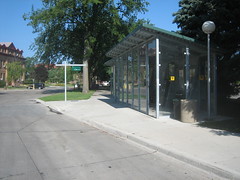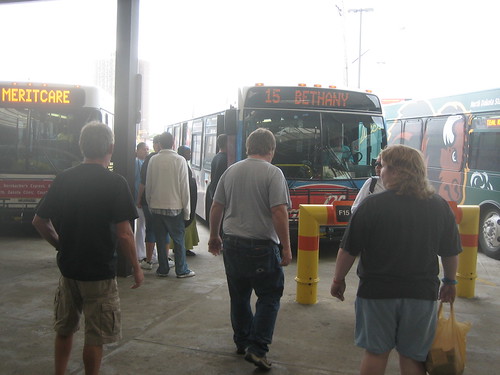Fargo and Moorhead’s joint bus system, Metro Area Transit, was the first system on which I was a regular rider. For many students, college is their first experience with public transportation, whether for convenience on campus or for reliance due to not having a car. Though I wasn’t such a transit enthusiast back then as I am now, I certainly wasn’t against it and wanted to make the best of it and judge for myself how convenient and easy or inconvenient and slow it actually was. I also did not (and still do not) have a car, so before making friends it was really my only means of getting around town. Since campus is relatively small, I pretty much just walked or biked to class and my on campus job, as my dorm was only about a block from the hub of academic buildings along Albrecht Blvd.
Two circulator routes ran through campus, Route 31 On-Campus Circulator every 15 minutes, and Route 32 Near-Campus Circulator, serving University Village and other apartments nearby every 30 minutes. I would occasionally ride one of these a few blocks to or from class if it happened to be coming by at the right time. A new night circulator, Route 35 started during spring semester 2008, running between campus and University Village from 8 – 10:07pm.
My fall semester (2006) I would occasionally ride the bus out to Target or West Acres mall to run errands on the weekends. It would require a transfer downtown at the GTC so all together it probably took half an hour each way – not bad, but certainly longer than driving. Route 15 serves West Acres from downtown and was always pretty busy. One time I recall standing room only on the ride back with nearly 50 passengers on board according to a fellow rider’s count – quite crowded for a 30-foot low floor bus.
In the spring I had class at NDSU Downtown twice a week so I began taking the bus regularly, as most of my classmates did too. Route 13 connects campus to downtown ad the GTC. Presumably after NDSU Downtown opened, MAT added 13B to provide more frequent service between campus and downtown on school days. While 13A runs along the regular route, 13B does not run as far north so its a quicker trip back to campus. The two routes alternate, each with 30 minute headways, to provide 15 minute service to downtown and back during the day.
 Earlier this year MAT expanded the Memorial Union bus shelter on campus and added a bus locator display, utilizing on-board GPS to track the whereabouts of 13A and 13B. With a very simple time schedule, I’m not sure this was necessary, but with new buses it probably wasn’t a major expense to implement and has implications for more trackers around the metro that could improve legibility and ease-of-use for the whole system. The tracker should be nice in the winter when buses typically run a few minutes behind schedule due to road conditions and inclement weather.
Earlier this year MAT expanded the Memorial Union bus shelter on campus and added a bus locator display, utilizing on-board GPS to track the whereabouts of 13A and 13B. With a very simple time schedule, I’m not sure this was necessary, but with new buses it probably wasn’t a major expense to implement and has implications for more trackers around the metro that could improve legibility and ease-of-use for the whole system. The tracker should be nice in the winter when buses typically run a few minutes behind schedule due to road conditions and inclement weather.
With the growth of NDSU’s downtown campus, MAT is planning for additional bus service between campuses. Especially for business students who do not have to essentially live at studio like architecture students, this should be a convenient means of getting between classes. Evidently no student parking will be provided at either of the two new campus buildings, which is a concern of architecture students who frequently will be working there all hours of the night when buses do not run.
Generally Metro Area Transit is a well run transit system with 22 routes serving Fargo, Moorhead, and West Fargo. I always had a good experience riding, with friendly drivers, well maintained buses, and sufficient schedule/route information provided.
When I was back in the area last weekend, I stopped by the GTC to get some pictures and even rode a route for a few blocks (my old Bison Card still grants me free rides). It was fun to check it out again, especially now that I have a better understanding of the ins and outs of transit operation as a driver for CyRide. MAT is a decent system that is certainly better and more adaptive than Cedar Rapids Transit and could probably rival CyRide if it had the same resources and ridership demand.
Check out my MAT bus pictures on Flickr.
More info on MAT’s website at www.matbus.com.
